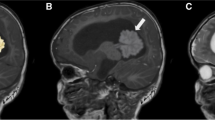Abstract
The study aimed to investigate the clinical implications and natural history of primary intraparenchymal lesions in patients with neurofibromatosis type 2. Radiological findings of 15 neurofibromatosis type 2 cases were retrospectively collected. Twenty-seven primary intraparenchymal lesions were observed in 7 out of 15 patients (47%). Cortical/subcortical T2 hyperintense lesions and enlarged Virchow–Robin spaces were the most common findings in five and four patients, respectively. During the follow-up period (median 84 months), one new primary intraparenchymal lesion was identified and increased lesions were observed in two cases on contrast-enhanced MRI. Surgical resection was performed in one case pathologically diagnosed with atypical meningioma. Twenty-five other lesions without contrast enhancement presented no apparent growth during follow-up. Although most primary intraparenchymal lesions are benign, a subset of cases would present newly developed or increased lesions on contrast-enhanced MRI. Careful monitoring is necessary for such cases, and pathological confirmation should be considered.


Similar content being viewed by others
Data availability
The dataset supporting this article is included in full within the article.
References
Asthagiri AR, Parry DM, Butman JA et al (2009) Neurofibromatosis type 2. Lancet 373(9679):1974–1986
Vargas WS, Heier LA, Rodriguez F, Bergner A, Yohay K (2014) Incidental parenchymal magnetic resonance imaging findings in the brains of patients with neurofibromatosis type 2. Neuroimage Clin 4:258–265
Kanda Y (2013) Investigation of the freely available easy-to-use software ‘EZR’ for medical statistics. Bone Marrow Transplant 48(3):452–458
Anand G, Vasallo G, Spanou M et al (2018) Diagnosis of sporadic neurofibromatosis type 2 in the paediatric population. Arch Dis Child 103(5):463–469
Muir KE, Sargent M, Boelman C (2018) A surprising cause of epilepsy: whole exome sequencing in a child with focal cortical dysplasia identifies neurofibromatosis type 2. Pediatr Neurol 85:79–81
Fedi M, Kalnins RM, Shuey N, Fitt GJ, Newton M, Mitchell LA (2009) Cystic meningioangiomatosis in neurofibromatosis type 2: an MRI-pathological study. Br J Radiol 82(979):e129–e132
Wiestler OD, von Siebenthal K, Schmitt HP, Feiden W, Kleihues P (1989) Distribution and immunoreactivity of cerebral micro-hamartomas in bilateral acoustic neurofibromatosis (neurofibromatosis 2). Acta Neuropathol 79(2):137–143
Goutagny S, Bah AB, Henin D et al (2012) Long-term follow-up of 287 meningiomas in neurofibromatosis type 2 patients: clinical, radiological, and molecular features. Neuro Oncol 14(8):1090–1096
Papic V, Lasica N, Jelaca B et al (2021) Primary intraparenchymal meningiomas: a case report and a systematic review. World Neurosurg 153:52–62
Groeschel S, Chong WK, Surtees R, Hanefeld F (2006) Virchow-Robin spaces on magnetic resonance images: normative data, their dilatation, and a review of the literature. Neuroradiology 48(10):745–754
Acknowledgements
The authors would like to thank Enago (www.enago.jp) for the English language review.
Funding
This research was supported by JSPS KAKENHI Grant Number JP 19K09519.
Author information
Authors and Affiliations
Contributions
YI contributed to conception of study, data acquisition, data analysis, and draft writing. TH, HO, MO, RS, HM, SY, ST, and KK contributed to data acquisition. Radiological diagnosis was performed by TH and HK. IY performed statistical analysis. MF contributed to study supervision. All authors have reviewed and approved the final version of the manuscript.
Corresponding author
Ethics declarations
Conflict of Interest
I. Yokota reports grants from KAKENHI, AMED, and Health, Labour and Welfare Policy Research Grants, research fund by Nihon Medi-Physics, and speaker fees from Chugai Pharmaceutical Co, AstraZeneca plt, Japan Tobacco Pharmaceutical Division, and Nippon Shinyaku Co, outside the submitted work. Y. Ishi, T. Harada, H. Okada, M. Okamoto, R. Sawaya, H. Motegi, S. Yamaguchi, S. Terasaka, K. Kudo, and M. Fujimura declare that they have no competing interests.
Ethics approval
Ethical approval was given by the institutional review board that was obtained prior to the study (Approval Number 018–0863). There was a waived informed consent modus for this study.
Consent to participate
As this was a retrospective study, the requirement for informed consent was waived.
Consent for publication
As this was a retrospective study, the requirement for informed consent was waived.
Additional information
Publisher’s note
Springer Nature remains neutral with regard to jurisdictional claims in published maps and institutional affiliations.
Supplementary Information
Below is the link to the electronic supplementary material.
Rights and permissions
About this article
Cite this article
Ishi, Y., Harada, T., Kameda, H. et al. Variations and natural history of primary intraparenchymal lesions associated with neurofibromatosis type 2. Neuroradiology 64, 393–396 (2022). https://doi.org/10.1007/s00234-021-02809-5
Received:
Accepted:
Published:
Issue Date:
DOI: https://doi.org/10.1007/s00234-021-02809-5




